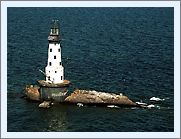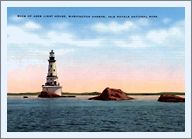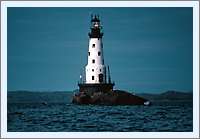|
Historical Information

Consisting of a strip of exposed
rock 50 feet wide and 210 feet long, with it highest point some sixteen
feet above the water, Rock of Ages lies two and a half miles off the
western end of Isle Royale. While the 205-foot wooden sidewheel steamer
CUMBERLAND had been the rockís only victim in over a half century of
Superior navigation, changing navigation patterns in the final decade of
the nineteenth century suddenly made Rock of Ages a critical impediment
to safe navigation on the big lake.
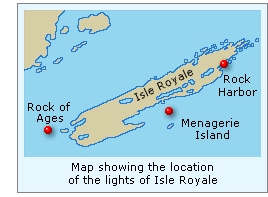 As Duluth grew to preeminence as the lakeís major shipping port, a
growing number of mariners were choosing to set a course along the
northern shore during Superiorís violent storms in order to avoid the
uncertain and changeable conditions of open water. With Rock of Ages
lurking directly in the path of vessels choosing this course, a cry
arose in the maritime community for the establishment of a Light on Rock
of Ages. Concurring that the situation represented a disaster waiting to
happen, the Lighthouse Board first recommended that a Congressional
appropriation of $50,000 be made for construction of a Light and fog
signal on The Rock in its annual report for 1896. As Duluth grew to preeminence as the lakeís major shipping port, a
growing number of mariners were choosing to set a course along the
northern shore during Superiorís violent storms in order to avoid the
uncertain and changeable conditions of open water. With Rock of Ages
lurking directly in the path of vessels choosing this course, a cry
arose in the maritime community for the establishment of a Light on Rock
of Ages. Concurring that the situation represented a disaster waiting to
happen, the Lighthouse Board first recommended that a Congressional
appropriation of $50,000 be made for construction of a Light and fog
signal on The Rock in its annual report for 1896.
Congress ignored the request for of the following two years.
Surprisingly, even the loss of the 257-foot wooden-hulled propeller
HENRY CHISHOLM on Rock of Ages on October 20, 1898 did nothing to spur
action, and the Board continued to repeat its plea for funding on an
annual basis until 1900. Realizing that it had grossly underestimated
the cost for establishing a first class Light in such a desolate
location, the Board increased its estimate for construction to $125,000
in its annual report for 1900. With Congress continuing to turn a deaf
ear to its pleas, the Board decided to take a different tack in 1903,
and requested a lesser appropriation of $25,000 to fund a detailed
survey and examination of the site.
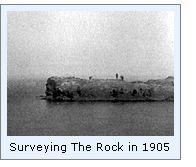 Congress finally responded with the requested appropriation on March
3, 1905, and a surveying and engineering team was dispatched to Rock of
Ages from Detroit that summer. On June 30, 1906, a second appropriation
of $50,000 was made, and congressional approval was given for the
construction of the new station provided that total construction costs
could be kept below a ceiling of $100,000. Agreeing with the budgetary
limitations, Eleventh District Engineer Major Charles Keller drew up
detailed plans and specifications for the new station over the winter of
1906 - 1907. Plans for the new tower borrowed heavily from current state
of the art construction methods in use in skyscraper construction, with
a central structural steel skeleton structure supporting masonry tower
floors and walls. As an indicator of the importance placed on this new
station, Keller's plans called for the tower to be capped by a massive
Second Order Fresnel lens. With an appropriation of the remaining $50,000 on
March 4, 1907, construction of the new station was completely funded,
and Keller awarded contracts for supplying the necessary building
materials, with the contract for the towerís steel skeleton support
structure awarded to the Russell Wheel and Foundry Company of Detroit. Congress finally responded with the requested appropriation on March
3, 1905, and a surveying and engineering team was dispatched to Rock of
Ages from Detroit that summer. On June 30, 1906, a second appropriation
of $50,000 was made, and congressional approval was given for the
construction of the new station provided that total construction costs
could be kept below a ceiling of $100,000. Agreeing with the budgetary
limitations, Eleventh District Engineer Major Charles Keller drew up
detailed plans and specifications for the new station over the winter of
1906 - 1907. Plans for the new tower borrowed heavily from current state
of the art construction methods in use in skyscraper construction, with
a central structural steel skeleton structure supporting masonry tower
floors and walls. As an indicator of the importance placed on this new
station, Keller's plans called for the tower to be capped by a massive
Second Order Fresnel lens. With an appropriation of the remaining $50,000 on
March 4, 1907, construction of the new station was completely funded,
and Keller awarded contracts for supplying the necessary building
materials, with the contract for the towerís steel skeleton support
structure awarded to the Russell Wheel and Foundry Company of Detroit.
In order to support such a difficult offshore construction site,
Kellerís plans called for the establishment of a base station in
Washington Harbor on Isle Royale using a number of leased abandoned
mining buildings at the head of the harbor. Here, supplies could be
stored, components prefabricated, and quarters for the work crew
established until work on The Rock had progressed to a point at which
quarters could be established on the rock itself. A chartered steam
barge loaded with materials left the Detroit Depot on May 21, 1908
arriving in Washington Harbor on May 27. After erecting a pair of
landing wharves, installing a tramway to transport materials and the
rehabilitation of the old mining structures, a 50-man work crew was
dispatched to begin work on The Rock itself.
 Construction on the Rock began with a small crew of quarrymen
delivered to the site, where they set about the task of blasting of a
flat section at the west end of the rock mass to a level of
approximately two feet above the water level. With site preparation
completed in June, a circular pier with walls of heavy riveted steel
plates standing fifty feet in diameter was erected. Standing twenty-five
feet in height, the upper walls flared out in a graceful curve to 56
feet in diameter at the top in order to form a wave deflector. With
completion of the pier walls, a sturdy timber platform was erected and
attached to the east side of the pier to serve as a working area from
the work crew could begin the process of filling the pier casing with
concrete. The lighthouse tender AMARANTH, her holds loaded with gravel
and cement, arrived at the site and anchored in deep water just off the
Rock. Using a large cement mixer on her deck, a crew set about mixing
innumerable loads of concrete and transferring them by boom to a scow
for transport to the Rock, where the construction crew poured
innumerable layers within the circular pier. As the concrete level
within the pier rose, forms were placed at its center to create a
two-story cellar lined with porous tile. At the very center of these
cellars, a steel column was integrated with its lower end lagged into a
footing in the floor of the lower cellar. This column was to serve as
the central core of the steel skeleton, and as such was designed to
transfer the load of the entire structure directly down to the bedrock
below. Construction on the Rock began with a small crew of quarrymen
delivered to the site, where they set about the task of blasting of a
flat section at the west end of the rock mass to a level of
approximately two feet above the water level. With site preparation
completed in June, a circular pier with walls of heavy riveted steel
plates standing fifty feet in diameter was erected. Standing twenty-five
feet in height, the upper walls flared out in a graceful curve to 56
feet in diameter at the top in order to form a wave deflector. With
completion of the pier walls, a sturdy timber platform was erected and
attached to the east side of the pier to serve as a working area from
the work crew could begin the process of filling the pier casing with
concrete. The lighthouse tender AMARANTH, her holds loaded with gravel
and cement, arrived at the site and anchored in deep water just off the
Rock. Using a large cement mixer on her deck, a crew set about mixing
innumerable loads of concrete and transferring them by boom to a scow
for transport to the Rock, where the construction crew poured
innumerable layers within the circular pier. As the concrete level
within the pier rose, forms were placed at its center to create a
two-story cellar lined with porous tile. At the very center of these
cellars, a steel column was integrated with its lower end lagged into a
footing in the floor of the lower cellar. This column was to serve as
the central core of the steel skeleton, and as such was designed to
transfer the load of the entire structure directly down to the bedrock
below.
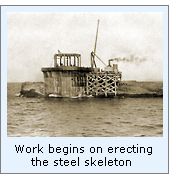 With the surface of the pier complete, and thus able to serve as a
work platform for the continuing construction of the tower, a large
bunkhouse was erected on the timber platform, and the construction crew
was able to live on the Rock on a full time basis. With daily trips to
and from the Rock no longer necessary and work progressed at an
increased rate, and the skeletal steel core of the structure began to
rise quickly. With the surface of the pier complete, and thus able to serve as a
work platform for the continuing construction of the tower, a large
bunkhouse was erected on the timber platform, and the construction crew
was able to live on the Rock on a full time basis. With daily trips to
and from the Rock no longer necessary and work progressed at an
increased rate, and the skeletal steel core of the structure began to
rise quickly.
Work continued through the 1908 season of navigation until all
brickwork and masonry was complete, the main deck was fitted-out, the
service room and lantern installed, and installation of the stationís
mechanical systems, including the steam heating plant, fog signal
equipment and water storage tanks was underway. With the glazing of the
lantern complete, a temporary fixed red Third Order Fresnel lens
was
installed and a single six-inch air operated fog siren placed into
operation on the night of October 22. Thomas Ervine was appointed as the
stationís first Head Keeper, however Second Assistant William Duggan
was first to report for duty at the station on October 2, with Irvine
and First Assistant Lee Benton arriving together on October 27. Keeper
Irvine was an eight-year lighthouse service veteran, with previous
assignments at Outer Island and Au Sable Point, the latter of which was
likely considered to have prepared him well for duty at a remote station
such as Rock of Ages. With construction crew members available to lend
assistance as needed, the Third Assistant Keeper position would remain
unfilled until January, 1910. As violent storms began sweeping through
the area, the station was closed on November 4, 1908, and construction
ended until improved weather conditions allowed resumption of work the
following year.
 With insufficient funding available in the $100,000 total
appropriation to allow the purchase of the permanent Second
Order Fresnel lens lens for the station,
Congress appropriated an additional $15,000 for a new lens on March 4.
Responsibility for specifying and ordering the new lens was delegated to
the Chief Engineer of the Third Lighthouse District, and an order for
the lens was placed with Parisian lens manufacturer Barbier, Benard
& Turenne on March 26. With insufficient funding available in the $100,000 total
appropriation to allow the purchase of the permanent Second
Order Fresnel lens lens for the station,
Congress appropriated an additional $15,000 for a new lens on March 4.
Responsibility for specifying and ordering the new lens was delegated to
the Chief Engineer of the Third Lighthouse District, and an order for
the lens was placed with Parisian lens manufacturer Barbier, Benard
& Turenne on March 26.
Back on Lake Superior, work resumed at the Rock in early 1909.
Between July 1 and August 31 all of the stationís interior work was
installed and painted, the pier surface paved, a chain railing installed
around the outer perimeter of the pier, and a permanent 11 foot by 24
foot landing crib erected.
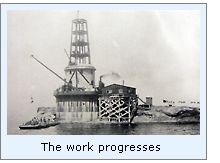 On completion, the tower stood eight stories in height, and offered
relatively large and comfortable quarters for the complement of four
keepers assigned to the station. A steam heating plant located in the
upper cellar provided heat to cast iron radiators in all rooms, and the
first deck was home to the fog signal plant and hoisting engines for the
pillar crane located at the edge of the pier level. This crane was used
both for raising supplies delivered by the lighthouse tenders at the
wharf and for raising the keeperís boat for storage on the safety of
the pier deck. An office and common room made up the second deck, and a
mess room and kitchen the third. The Keeper and First Assistantís
quarters were located on the fourth deck, with the Second and Third
Assistants quarters immediately above on the Fifth deck. A service room
and watch room comprised the sixth and seventh decks, leaving the huge
lantern capping the structure above. On completion, the tower stood eight stories in height, and offered
relatively large and comfortable quarters for the complement of four
keepers assigned to the station. A steam heating plant located in the
upper cellar provided heat to cast iron radiators in all rooms, and the
first deck was home to the fog signal plant and hoisting engines for the
pillar crane located at the edge of the pier level. This crane was used
both for raising supplies delivered by the lighthouse tenders at the
wharf and for raising the keeperís boat for storage on the safety of
the pier deck. An office and common room made up the second deck, and a
mess room and kitchen the third. The Keeper and First Assistantís
quarters were located on the fourth deck, with the Second and Third
Assistants quarters immediately above on the Fifth deck. A service room
and watch room comprised the sixth and seventh decks, leaving the huge
lantern capping the structure above.
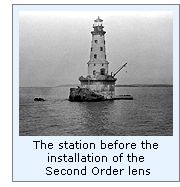 Manufacturing of the new lens was completed in early 1910, and the
lens was crated for shipment from Paris to the main lighthouse depot on
Staten Island that summer. After receipt of the lens at the Detroit
depot, the Eleventh District Lampist loaded the crates aboard the
AMARANTH, arriving at Rock of Ages in early September. The Lampist
uncrated the cast iron pedestal and hoisted it into the mechanical room
below the lantern. The lens itself was designed with four lightning
flash panels, each consisting of 7 refracting and 17 reflecting prisms,
and was floated atop the pedestal on a bath of mercury, designed to
virtually eliminate rotational friction. Turned by a clockwork
mechanism, the Lampist carefully adjusted the rotation speed of the
massive lens to ensure that the stationís designated characteristic of
a double flash every ten seconds was matched perfectly. Illuminated by a
double-tank incandescent oil vapor lamp, the double flashes emitted a
remarkable 940,000 candlepower, and by virtue of its situation at a
focal plane of 117 feet, the lens boasted a visible range of nineteen
miles on the night of its initial exhibition on September 15, 1910. Manufacturing of the new lens was completed in early 1910, and the
lens was crated for shipment from Paris to the main lighthouse depot on
Staten Island that summer. After receipt of the lens at the Detroit
depot, the Eleventh District Lampist loaded the crates aboard the
AMARANTH, arriving at Rock of Ages in early September. The Lampist
uncrated the cast iron pedestal and hoisted it into the mechanical room
below the lantern. The lens itself was designed with four lightning
flash panels, each consisting of 7 refracting and 17 reflecting prisms,
and was floated atop the pedestal on a bath of mercury, designed to
virtually eliminate rotational friction. Turned by a clockwork
mechanism, the Lampist carefully adjusted the rotation speed of the
massive lens to ensure that the stationís designated characteristic of
a double flash every ten seconds was matched perfectly. Illuminated by a
double-tank incandescent oil vapor lamp, the double flashes emitted a
remarkable 940,000 candlepower, and by virtue of its situation at a
focal plane of 117 feet, the lens boasted a visible range of nineteen
miles on the night of its initial exhibition on September 15, 1910.
Life at Rock of Ages settled into a regular routine. With four
keepers assigned to the station, a regular rotating schedule was
established through which one of the keepers was scheduled for a weekís
leave every month. Free time at the station was spent in reading,
playing cards, or fishing around the Rock. The establishment of a
radiobeacon at the station in 1929 forced the keepers to quickly
acquaint themselves with electronics, and was likely a source of
frequent problem, as the early equipment proved to be unreliable and
prone to frequent breakdowns. 1930 saw the electrification of the
station through the installation of electric generators powered by
diesel engines, and electrification in turn paved the way for the
replacement of the single air siren with a pair of Tyfon fog signals in
1931. In order to provide the widest possible range of dispersion, the
horns for these signals were mounted on opposing sides of the tower.
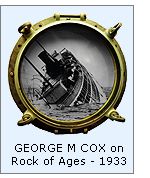 In a foggy May 28th in 1933, with the fog signal screaming out across
the lake, Keeper John F. Soldenski stood watch in watch room to keep an
eye out for approaching vessels. Imagine his surprise and he watched as
a the 259-foot passenger vessel GEORGE M COX came lumbering out of the
fog at seventeen knots, heard the horn, and turned directly into the
Reef. The COX had been built as PURITAN in 1901, and had recently been
refitted as a luxury liner, and renamed after the Shipping Magnate who
had commissioned the refit. As such, she was on her maiden voyage from
Chicago to Port Arthur, with a stop in Houghton. Onboard were 125
crewmembers, company dignitaries and their friends. In a foggy May 28th in 1933, with the fog signal screaming out across
the lake, Keeper John F. Soldenski stood watch in watch room to keep an
eye out for approaching vessels. Imagine his surprise and he watched as
a the 259-foot passenger vessel GEORGE M COX came lumbering out of the
fog at seventeen knots, heard the horn, and turned directly into the
Reef. The COX had been built as PURITAN in 1901, and had recently been
refitted as a luxury liner, and renamed after the Shipping Magnate who
had commissioned the refit. As such, she was on her maiden voyage from
Chicago to Port Arthur, with a stop in Houghton. Onboard were 125
crewmembers, company dignitaries and their friends.
Soldenski and his assistants Whipple, Marshall and Marrow managed to
rescue all 125 crew and passengers, with all of them forced to spend the
night crammed into the tight quarters of the lighthouse, many of them
sitting on the spiral stairs. While the Portage lifeboat arrived late
that night and took of a few of the injured passengers, it was not until
the following day that the Coast Guard Cutter CRAWFORD arrived to take
the remainder of the marooned passengers to the safety of shore in Two
Harbors, Minnesota. While the Cox was the only wreck to occur on The
Rock after the establishment of the lighthouse, it was not the only
tragedy that would be associated with the station.
I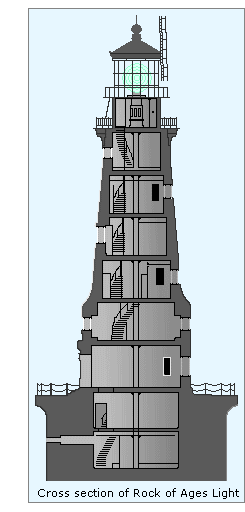 n the summer of 1939, the lighthouse tender AMARANTH had been
dispatched to Rock of Ages to replace one of the stationís aging
Fairbanks Morse air compressors with a new unit. The tender carefully
approached the Light Station and dropped anchor in deep water a short
distance from the station. A steel scow had been lowered into the water
by the tenderís boom, and the new compressor lowered onto the scow,
and powered by the tenderís launch, towed to the wharf alongside the
lighthouse. From there, the stationís steam winch had been used to
lift the new compressor onto the stationís main deck. The old
compressor had in turn been lowered onto the scow, and the launch was in
the process of returning to the AMARANTH with the old compressor. As the
scow approached the tender it became clear that the launch was making a
little too much headway, and the scow smashed into tenderís massive
hull. The inertia caused the heavy compressor to slide across the scowís
smooth deck, with the sudden load shift causing the scow to upend. A
couple of deckhands on the scow managed to jump from the scow to the
deck of the tender at the last second as the upended gunwale of the scow
smashed against the tenderís hull. Unfortunately, deckhand Robert
"Sonny" Bergmarker was less fortunate, ending up with his
lower body crushed between the scow and the tenderís hull. Crewmen
quickly hoisted Bergearker aboard the tender where first aid was
administered, however it was clear that Bergearker needed to get to a
hospital as soon as possible if he was to stand a chance of survival.
Quickly hoisting the scow and launch back onto the tenderís deck,
Captain OíDonnell ordered a full head of steam, and the venerable
tender headed for the nearest hospital in Houghton. The tenderís coal
passers worked at a feverish pitch to get their shipmate to the hospital
as quickly as possible. However, Bergearker sadly passed away before
they could get him into the hospital. n the summer of 1939, the lighthouse tender AMARANTH had been
dispatched to Rock of Ages to replace one of the stationís aging
Fairbanks Morse air compressors with a new unit. The tender carefully
approached the Light Station and dropped anchor in deep water a short
distance from the station. A steel scow had been lowered into the water
by the tenderís boom, and the new compressor lowered onto the scow,
and powered by the tenderís launch, towed to the wharf alongside the
lighthouse. From there, the stationís steam winch had been used to
lift the new compressor onto the stationís main deck. The old
compressor had in turn been lowered onto the scow, and the launch was in
the process of returning to the AMARANTH with the old compressor. As the
scow approached the tender it became clear that the launch was making a
little too much headway, and the scow smashed into tenderís massive
hull. The inertia caused the heavy compressor to slide across the scowís
smooth deck, with the sudden load shift causing the scow to upend. A
couple of deckhands on the scow managed to jump from the scow to the
deck of the tender at the last second as the upended gunwale of the scow
smashed against the tenderís hull. Unfortunately, deckhand Robert
"Sonny" Bergmarker was less fortunate, ending up with his
lower body crushed between the scow and the tenderís hull. Crewmen
quickly hoisted Bergearker aboard the tender where first aid was
administered, however it was clear that Bergearker needed to get to a
hospital as soon as possible if he was to stand a chance of survival.
Quickly hoisting the scow and launch back onto the tenderís deck,
Captain OíDonnell ordered a full head of steam, and the venerable
tender headed for the nearest hospital in Houghton. The tenderís coal
passers worked at a feverish pitch to get their shipmate to the hospital
as quickly as possible. However, Bergearker sadly passed away before
they could get him into the hospital.
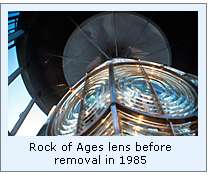 That same year, President Franklin Roosevelt decided to eliminate the
Bureau of Lighthouses, and placed responsibility for the nationís aids
to navigation under the umbrella of the Coast Guard. The Bureau Keepers
were given a choice of either maintaining their civilian status, or
entering the Coast Guard, and approximately 50% of the old Wickies made
the switch to military life. Bill Muessel was one of those who chose to
make the change. After entering lighthouse service early in 1939, Bill
had served six years on the AMARANTH and TAMARACK before spending a year
at Outer Island and a second year on Passage Island. After graduation
from Aids to Navigation school in Groton, Connecticut, he was assigned
as Officer in Charge at Rock of Ages in 1949, in which capacity he
served until 1954. I was fortunate to be able to interview Bill in June
2002, and he gave me some wonderful memories of his time on The Rock.
Click here to read a complete transcript of my interview with Bill. That same year, President Franklin Roosevelt decided to eliminate the
Bureau of Lighthouses, and placed responsibility for the nationís aids
to navigation under the umbrella of the Coast Guard. The Bureau Keepers
were given a choice of either maintaining their civilian status, or
entering the Coast Guard, and approximately 50% of the old Wickies made
the switch to military life. Bill Muessel was one of those who chose to
make the change. After entering lighthouse service early in 1939, Bill
had served six years on the AMARANTH and TAMARACK before spending a year
at Outer Island and a second year on Passage Island. After graduation
from Aids to Navigation school in Groton, Connecticut, he was assigned
as Officer in Charge at Rock of Ages in 1949, in which capacity he
served until 1954. I was fortunate to be able to interview Bill in June
2002, and he gave me some wonderful memories of his time on The Rock.
Click here to read a complete transcript of my interview with Bill.
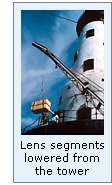 The massive Second Order lens was removed from the lantern over a
five day period in 1985, and a 12-volt DC solar-powered 300 mm optic
installed in its place. The intricate Fresnel was reassembled and placed
on display at the Windigo Ranger Station in Washington Harbor some five
miles away. The massive Second Order lens was removed from the lantern over a
five day period in 1985, and a 12-volt DC solar-powered 300 mm optic
installed in its place. The intricate Fresnel was reassembled and placed
on display at the Windigo Ranger Station in Washington Harbor some five
miles away.
To this day, the Cox stills sits teetering on the edge of Rock of
Ages Reef, and is a popular site for sport divers. On the shallow side
of the reef, her bow wreckage sits in 15 ft of water, while at a depth
of 45 feet, her two boilers can be seen, and her stern lies keel-up
between a depth of 50 and 90 feet. Both her screw and drive shaft are
still intact.
The Rock of Ages station is now part of Isle Royale Park, and because
landing at the dock is considered a dangerous proposition, the structure
is not open to the public. However, the 300 mm optic still beams from
the lantern every night, and the station still serves as an active aid
to navigation.

Keepers of
this Light

Click here
to see a complete listing of all Rock of Ages Light keepers compiled by
Phyllis L. Tag of Great Lakes Lighthouse Research.

Seeing this Light

Keweenaw Excursions offers a lighthouse
cruise which passes Rock of Ages on board the KEWEENAW STAR out of
Houghton, Michigan. For more information on any of their tours visit
their website,
or telephone Keweenaw Excursions at (906) 482-0884.

Reference
Sources

Annual reports of the Lighthouse
Board, various, 1896 - 1912
Great Lakes Light Lists, various, 1917 - 1961
Great Lakes Pilot, 1958, US Army Corps of Engineers
Telephone interview with Bill Muessel, 6/2/2002
Email correspondence with Don Nelson, various, 2002
Wreck SCUBA Diving, Isle Royale, Lake Superior, website.
Keeper listings for this light appear
courtesy of Great
Lakes Lighthouse Research
|
